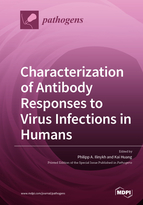Characterization of Antibody Responses to Virus Infections in Humans
A special issue of Pathogens (ISSN 2076-0817). This special issue belongs to the section "Viral Pathogens".
Deadline for manuscript submissions: closed (1 March 2022) | Viewed by 29860
Special Issue Editors
Interests: hemorrhagic fever; filoviruses; animal models of filovirus infection; glycoproteins; heterologous immunity; viral antibodies; neutralizing antibodies; Fc-mediated protective effects; epitope mapping; immunotherapeutic
Interests: emerging infectious diseases; respiratory pathogen; RNA virus; influenza; filovirus; Ebola; Marburg; virus evolution
Special Issue Information
Dear Colleagues,
Humoral immunity is an important body defense system against virus infection and is correlated to patient health status. Antibody response is a key factor to controlling virus replication. During infection, viruses induce the production of antibodies differing in their isotype, neutralization capacity, breadth of neutralization, recognition of surface versus internal viral proteins, epitope specificity, and overall structure. These and other yet unidentified factors determine the role of antibodies in the clearance of infection through the inhibition of various steps of the virus life cycle in addition to activation of complement and/or specific immune cell populations which facilitate elimination of viral particles and the infected cells by antibody-dependent cytotoxicity, phagocytosis, and other mechanisms. However, in certain instances, some “adverse effects” of the antibody response, such as antibody-dependent enhancement of infection or increased inflammation resulting from the deposition of immune complexes, may be at play and exacerbate the infection. Adding to the complexity of interaction between viruses and host immune system, some viruses have exploited multiple mechanisms to compromise antibody production, which helps them to overcome the resistance of host organism and establish infection. This phenomenon often contributes to the differences in magnitude and longevity of the humoral response to natural infections in comparison with vaccines. Despite recent advancements in the characterization of antibody responses to a number of human pathogens, including human immunodeficiency virus 1, influenza virus, dengue virus, chikungunya virus, rabies virus, paramyxoviruses, poxviruses, hantaviruses, filoviruses, and coronaviruses, at both molecular and epidemiological levels, critical knowledge gaps still exist. In particular, many viral and host factors determining the dynamics of antibody response and its role in infection pathogenesis as well as the mechanisms of antiviral and proviral antibody effects remain undefined. Undoubtedly, such information will be vital to guide the design of vaccines and therapeutic strategies based on passive immunization.
This Special Issue of Pathogens aims at addressing the unresolved key issues that hamper our understanding of the interactions between viruses, antibodies, and other host factors. The new presented studies will shed light on the multifaced biological role that antibodies play during the course of virus infections. Both original research and review articles are welcome. Potential topics include, but are not limited to:
- Structure of immune complexes
- Role of antibodies in pathogenesis of viral infections
- Mechanisms of virus-induced suppression of antibody response
- Dynamics of the humoral immune response during viral infections
- Serological surveillance
We looking forward to receiving your unique contribution.
Dr. Philipp A. Ilinykh
Dr. Kai Huang
Guest Editors
Manuscript Submission Information
Manuscripts should be submitted online at www.mdpi.com by registering and logging in to this website. Once you are registered, click here to go to the submission form. Manuscripts can be submitted until the deadline. All submissions that pass pre-check are peer-reviewed. Accepted papers will be published continuously in the journal (as soon as accepted) and will be listed together on the special issue website. Research articles, review articles as well as short communications are invited. For planned papers, a title and short abstract (about 100 words) can be sent to the Editorial Office for announcement on this website.
Submitted manuscripts should not have been published previously, nor be under consideration for publication elsewhere (except conference proceedings papers). All manuscripts are thoroughly refereed through a single-blind peer-review process. A guide for authors and other relevant information for submission of manuscripts is available on the Instructions for Authors page. Pathogens is an international peer-reviewed open access monthly journal published by MDPI.
Please visit the Instructions for Authors page before submitting a manuscript. The Article Processing Charge (APC) for publication in this open access journal is 2700 CHF (Swiss Francs). Submitted papers should be well formatted and use good English. Authors may use MDPI's English editing service prior to publication or during author revisions.
Keywords
- viruses
- antigens
- heterologous immunity
- viral antibodies
- neutralizing antibodies
- Fc-mediated protective effects
- epitope mapping
- antibody structure
- immune complexes
- immunotherapeutic
- serological surveillance








